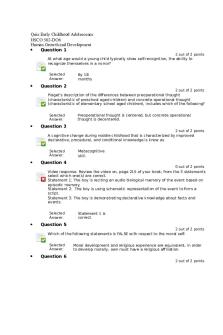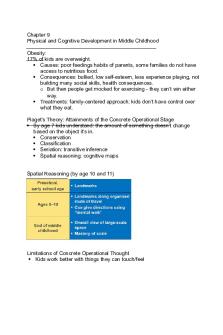Chapter 9 Early Childhood Cognitive Development PDF

| Title | Chapter 9 Early Childhood Cognitive Development |
|---|---|
| Author | Isabel Kittell |
| Course | Lifespan Growth and Development |
| Institution | Blinn College District |
| Pages | 12 |
| File Size | 141.8 KB |
| File Type | |
| Total Downloads | 17 |
| Total Views | 157 |
Summary
Larry Thomas' chapter 9 lecture notes...
Description
Chapter 9: Early Childhood: Cognitive Developmen Thursday, March 12, 2020
6:26 PM
Thinking during early childhood - Piaget: ○ Preoperational intelligence § Cognitive development between the ages of about 2 and 6 § Includes language and imagination § Suggests logical, operational thinking is not yet possible at this stage Symbolic thought ○ § Major accomplishment of preoperational intelligence § Allows a child to think symbolically, including understanding that words can refer to things not seen and that an item can symbolize something else § Helps explain animism ○ Preoperational thought: Animism § Involves belief that natural objects and phenomena are alive § Is related to egocentric reasoning § May be involved with rational as well as irrational ideas ○ Preoperational thought: obstacles to logic § Centration: includes a characteristic of preoperational thought whereby a yo child focuses (centers) on one idea, excluding all others; may include egocentrism § Focus on appearance: characteristic of preoperational thought whereby a you child ignores all attributes that are not apparent § Egocentrism: Piaget's term for young children's tendency to think about the world entirely from their own personal perspective ○ Preoperational thought § Static reasoning: characteristic of preoperational thought whereby a young c thinks that nothing changes. Whatever is not has always been and always wi § Irreversibility: characteristic of preoperational thought whereby a young chil thinks that nothing can be undone. A thing cannot be restored to the way it before a change occurred Conversation and logic ○ § Conversation: principle that the amount of a substance remains the same wh its appearance changes ○ All characteristics of preoperational thought are evident in classic conservation tas errors
ng g
ld be as n
○
○
same when its appearance changes All characteristics of preoperational thought are evident in classic conservation task errors § Young children fail to understand conservation of liquids because they focus (center) on what they see (appearance), noticing only the immediate (static) condition § It does not occur to them that they could reverse the process and recreate the liquid's level of a moment earlier (irreversibility) Limitations of Piaget's research § Piagetian conservation task require words § Modifications of tasks resulted in better performance of younger children § Piaget underestimated cognition during early childhood
Vygotsky: social learning - Vygotsky: social learning ○ Every aspect of children's cognitive development is embedded in the social context - Apprentice in thinking ○ Someone whose intellectual growth is stimulated and directed by older, more skilled members of society - Mentors ○ Present challenges ○ Offer assistance (without taking over) ○ Add crucial information ○ Encourage motivation - Guided participation ○ Process by which people learn from others who guide their experiences and explorations - Zone of proximal development (ZPD) ○ Skills that a person can exercise only with assistance, not yet independently - Scaffolding ○ Temporary support that is tailored to a learner's needs and abilities and aimed at helping the learner master the next task in a given learning process - Over imitation ○ Tendency of children to copy an action that is not a relevant part of behavior to be learned ○ Common among 2 to 6 year olds when they imitate adult actions that are irrelevant and inefficient ○ Universal trait of young, socially motivated children Vygotsky: language as a tool
-
Words are the mediator between brain potential and comprehension ○ Language advances thinking § Internal dialogue or private speech § Social mediation § STEM curricula § Executive function development
Children's theories - Theory-theory ○ Children attempt to explain everything they see and hear ○ Children develop theories about intentions before they employ their impressive ability to imitate - Theory of mind ○ Involves a person's theory of what other people might be thinking ○ Is slow to develop but typically begins in most children at about age 4 ○ Can be seen when young children try to escape punishment by lying ○ This is a person's theory of what other people might be thinking ○ To have a theory of mind, children must realize that other people are not necessarily thinking the same thoughts that they themselves are ○ This realization seldom occurs before age 4 Brain and context - What strengthens theory of mind in young children? ○ Child's ability to develop theories correlates with the maturity of the prefrontal cortex and with advances in executive processing ○ Context and experience are relevant ○ Context and culture matter Language learning - Language is pivotal to every kind of cognition in early childhood - Early childhood is a sensitive period or best time to master vocabulary, grammar, and pronunciation - The average child knows about 500 words at age 2 and more than 10,000 at age 6 - Comprehension is always greater than production - Vocabulary explosion ○ Vocabulary builds quickly and comprehension greater than production ○ Verbs, adjectives, adverbs, conjunctions, and many nouns mastered - Fast mapping ○ Speedy and sometimes imprecise way in which children learn new words by tentatively placing them in mental categories according to their perceived meaning
-
Young children talk about many things to adults, to each other, to themselves, to their toys - unfazed by misuse, mispronunciation, ignorance, stuttering, and so on Language comes easily partly because preoperational children are not self critical about what they say Acquiring grammar ○ Grammar of a language § Structures, techniques, and rules that communicate meaning § Words order and word repetition, prefixes and suffixes, intonation, and emphasis Overregulation ○ § Application of rules of grammar even when exceptions occur § Makes language seem more "regular" than it actually is By age 4, many children overregularize that final s, talking about foots, ○ tooths, and mouses. This is actually evidence of increasing knowledge ○ Many children first say words correctly (feet, teeth, mice), repeating what they have heard ○ Later when they grasp the grammar and try to apply it, they overregularize, assuming that all constructions follow the regular path
Words and the limits of logic - Logical extension ○ Closely related to fast mapping ○ Occurs when children use words to describe other objects in same category Language - Learning two languages ○ Lower school achievement, diminished self-esteem, and inadequate employment result if a child is not proficient in English ○ Young bilingual children site both languages in the same areas of their brains ○ Adult second language learners usually show different activation sites for each language and are slowed down ○ Bilingual brain may provide some resistance to neurocognitive disorder - Language losses and gains ○ Language shifts: becoming more fluent in the school language than in their home language ○ Balanced bilingual § Being fluent in two languages, not favoring one over the other § Occurs if adults talk frequently, listen carefully, and value both languages
Effective strategies and experiences - Code-focused teaching - Book-reading - Parent education - Language enhancement - Preschool programs Early childhood education - Homes and schools: quality matters ○ If the home educational environment is poor, a good preschool program aids health, cognition, and social skills ○ If a family provides extensive learning opportunities and encouragement, the quality of the preschool is less crucial - Judging quality ○ Cannot be adequately judged by program name or sponsorship or professional assessment ○ Teacher-child interaction correlates with learning - Child centered or developmental programs ○ Stress children's natural inclination to learn through play rather than by following adult directions ○ Encourages self-paced exploration and artistic expression ○ Often show the influence of Piaget or Vygotsky, who thought that children learn through play with other children and through cultural practices that structure life ○ Montessori schools emphasize individual pride and accomplishment, presenting literacy-related tasks (such as outlining letters and looking at books) ○ The Reggio Emilia approach involves a famous program of early childhood education that originated in the town of Reggio Emilia, Italy; it encourages each child's creativity in a carefully designed setting - Teacher directed programs ○ Stress academic subjects taught by a teacher to an entire class ○ Help children learn letters, numbers, shapes, and colors, as well as how to listen to the teacher and sit quietly ○ Make a clear distinction between work and play ○ Are much less expensive, since the child/adult ratio can be higher - Intervention programs: Head Start ○ Most widespread early childhood education program in the United States ○ Begun in 1965 and funded by the federal government ○ Initially, the program was thought to be highly successful at raising children's intelligence; 10 years later, early gains were found to fade
○ ○
Head Start benefits were strongest for children in poverty, or in rural areas, or with disabilities (U.S. Department of Health and Human Services) They are likely to find other sources of early education, largely because of their parents' income, location, and stress
Long term gains from intensive programs - Long-term gains ○ Early intervention is effective if it is sufficiently intense with effective teachers - Evidence ○ Perry (high/scope) ○ Abecedarian ○ Child-parent centers - State programs ○ As of 2014, 40 states sponsor public education for young children although usually only for low-income 4 year olds ○ Programs are increasing, but almost half of 4 year olds and most 3 year olds are not in any education program ○ Spending per child has decreased; there is less child-centered and more teacher-directed education``...
Similar Free PDFs

Early Childhood Case Study
- 10 Pages

Andres Bonifacio Early Childhood
- 12 Pages

Quiz Early Childhood Adolescence
- 9 Pages

Early Childhood project
- 4 Pages

Transition in early childhood
- 4 Pages
Popular Institutions
- Tinajero National High School - Annex
- Politeknik Caltex Riau
- Yokohama City University
- SGT University
- University of Al-Qadisiyah
- Divine Word College of Vigan
- Techniek College Rotterdam
- Universidade de Santiago
- Universiti Teknologi MARA Cawangan Johor Kampus Pasir Gudang
- Poltekkes Kemenkes Yogyakarta
- Baguio City National High School
- Colegio san marcos
- preparatoria uno
- Centro de Bachillerato Tecnológico Industrial y de Servicios No. 107
- Dalian Maritime University
- Quang Trung Secondary School
- Colegio Tecnológico en Informática
- Corporación Regional de Educación Superior
- Grupo CEDVA
- Dar Al Uloom University
- Centro de Estudios Preuniversitarios de la Universidad Nacional de Ingeniería
- 上智大学
- Aakash International School, Nuna Majara
- San Felipe Neri Catholic School
- Kang Chiao International School - New Taipei City
- Misamis Occidental National High School
- Institución Educativa Escuela Normal Juan Ladrilleros
- Kolehiyo ng Pantukan
- Batanes State College
- Instituto Continental
- Sekolah Menengah Kejuruan Kesehatan Kaltara (Tarakan)
- Colegio de La Inmaculada Concepcion - Cebu










